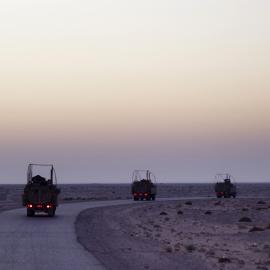After generations of authoritarian stagnation punctuated by moments of domestic repression and interstate war, in recent years, the Middle East has begun to move. The rise of radical Islamism, the invasion of Iraq and its chaotic aftermath, the uprisings of the Arab Spring and their bloody issue, and now a sustained drop in oil prices and successful negotiations with Iran—together these have opened up what could be an unsettling new era for all involved. What are the contours of this new Middle East? Will Washington continue to pull back from actively managing the region, or will it develop an appetite for renewed intervention? And how will developments reshuffle alignments and allegiances? These are the questions this package tries to answer, delving deep into the current turmoil and its implications for U.S. policy. To start, Steven Simon and Jonathan Stevenson argue that the U.S. shift to an “offshore balancing” approach, shunning ground operations and state building in the region, has been driven by a sensible recognition that Washington has dramatically reduced scope for successful intervention these days. But Daniel Byman says that counterterrorism from a distance is not enough and that renewed attempts at state building are necessary. Michael Mandelbaum thinks that in order to deter Tehran from going nuclear, the Iran deal should be supplemented by an explicit threat of U.S. military action in response to significant cheating, and Cyrus Amir-Mokri and Hamid Biglari explain the economic policy changes the Islamic Republic needs to enact in order to reap lasting benefits from the lifting of international sanctions. Ali Khedery reports on the ongoing disintegration of Iraq, arguing that decentralization presents the least bad alternative for the country’s future, and Stephen Walt and Jared Cohen offer strategies for dealing with the Islamic State (also called ISIS) on the ground and in cyberspace, respectively. And Ilan Goldenberg and Melissa Dalton, Michael Wahid Hanna, and Natan Sachs trace the contours of the new dynamics between the United States and the Gulf Cooperation Council, Egypt, and Israel, respectively. The old Middle East has been seriously shaken; where it persists or has been restored, such as in Saudi Arabia and Egypt, it limps on without confidence or permanence. The new Middle East remains a work in progress; from Iraq and Syria to Libya and Yemen, nobody knows how things will look when the dust settles. And whether, after the nuclear deal kicks in, Iran will choose conflict, integration, or a mixture of the two remains a mystery. Stay tuned.
You are reading a free article.
Subscribe to Foreign Affairs to get unlimited access.
- Paywall-free reading of new articles and a century of archives
- Unlock access to iOS/Android apps to save editions for offline reading
- Six issues a year in print, online, and audio editions
